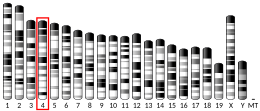RERE
Arginine-glutamic acid dipeptide repeats protein is a protein that in humans is encoded by the RERE gene.[5][6][7]
Function
[edit]This gene encodes a member of the atrophin family of arginine-glutamic acid (RE) dipeptide repeat-containing proteins. The encoded protein co-localizes with a transcription factor in the nucleus, and its overexpression triggers apoptosis. A similar protein in mouse associates with histone deacetylase and is thought to function as a transcriptional co-repressor during embryonic development. Recent reports also indicate that RERE and its Drosophila homolog associate with histone methyltransferases in regulating gene expression. Multiple transcript variants encoding different isoforms have been found for this gene.[7]
Interactions
[edit]RERE has been shown to interact with ATN1.[5]
References
[edit]- ^ a b c GRCh38: Ensembl release 89: ENSG00000142599 – Ensembl, May 2017
- ^ a b c GRCm38: Ensembl release 89: ENSMUSG00000039852 – Ensembl, May 2017
- ^ "Human PubMed Reference:". National Center for Biotechnology Information, U.S. National Library of Medicine.
- ^ "Mouse PubMed Reference:". National Center for Biotechnology Information, U.S. National Library of Medicine.
- ^ a b Yanagisawa H, Bundo M, Miyashita T, Okamura-Oho Y, Tadokoro K, Tokunaga K, Yamada M (May 2000). "Protein binding of a DRPLA family through arginine-glutamic acid dipeptide repeats is enhanced by extended polyglutamine". Human Molecular Genetics. 9 (9): 1433–42. doi:10.1093/hmg/9.9.1433. PMID 10814707.
- ^ Amler LC, Bauer A, Corvi R, Dihlmann S, Praml C, Cavenee WK, Schwab M, Hampton GM (Mar 2000). "Identification and characterization of novel genes located at the t(1;15)(p36.2;q24) translocation breakpoint in the neuroblastoma cell line NGP". Genomics. 64 (2): 195–202. doi:10.1006/geno.1999.6097. PMID 10729226.
- ^ a b "Entrez Gene: RERE arginine-glutamic acid dipeptide (RE) repeats". Archived from the original on 2010-12-05. Retrieved 2017-09-10.
Further reading
[edit]- Wang L, Rajan H, Pitman JL, McKeown M, Tsai CC (Mar 2006). "Histone deacetylase-associating Atrophin proteins are nuclear receptor corepressors". Genes & Development. 20 (5): 525–30. doi:10.1101/gad.1393506. PMC 1410805. PMID 16481466.
- Wang L, Charroux B, Kerridge S, Tsai CC (Jun 2008). "Atrophin recruits HDAC1/2 and G9a to modify histone H3K9 and to determine cell fates". EMBO Reports. 9 (6): 555–62. doi:10.1038/embor.2008.67. PMC 2427389. PMID 18451879.
- Seki N, Ohira M, Nagase T, Ishikawa K, Miyajima N, Nakajima D, Nomura N, Ohara O (Oct 1997). "Characterization of cDNA clones in size-fractionated cDNA libraries from human brain". DNA Research. 4 (5): 345–9. doi:10.1093/dnares/4.5.345. PMID 9455484.
- Waerner T, Gardellin P, Pfizenmaier K, Weith A, Kraut N (Apr 2001). "Human RERE is localized to nuclear promyelocytic leukemia oncogenic domains and enhances apoptosis". Cell Growth & Differentiation. 12 (4): 201–10. PMID 11331249.
- Yi J, Kloeker S, Jensen CC, Bockholt S, Honda H, Hirai H, Beckerle MC (Mar 2002). "Members of the Zyxin family of LIM proteins interact with members of the p130Cas family of signal transducers". The Journal of Biological Chemistry. 277 (11): 9580–9. doi:10.1074/jbc.M106922200. PMID 11782456.
- Wistow G, Bernstein SL, Wyatt MK, Behal A, Touchman JW, Bouffard G, Smith D, Peterson K (Jun 2002). "Expressed sequence tag analysis of adult human lens for the NEIBank Project: over 2000 non-redundant transcripts, novel genes and splice variants". Molecular Vision. 8: 171–84. PMID 12107413.
- Tomarev SI, Wistow G, Raymond V, Dubois S, Malyukova I (Jun 2003). "Gene expression profile of the human trabecular meshwork: NEIBank sequence tag analysis". Investigative Ophthalmology & Visual Science. 44 (6): 2588–96. doi:10.1167/iovs.02-1099. PMID 12766061.
- Zoltewicz JS, Stewart NJ, Leung R, Peterson AS (Jan 2004). "Atrophin 2 recruits histone deacetylase and is required for the function of multiple signaling centers during mouse embryogenesis" (PDF). Development. 131 (1): 3–14. doi:10.1242/dev.00908. PMID 14645126. S2CID 20498980. Archived (PDF) from the original on 2018-07-24. Retrieved 2019-09-03.
- Beausoleil SA, Jedrychowski M, Schwartz D, Elias JE, Villén J, Li J, Cohn MA, Cantley LC, Gygi SP (Aug 2004). "Large-scale characterization of HeLa cell nuclear phosphoproteins". Proceedings of the National Academy of Sciences of the United States of America. 101 (33): 12130–5. Bibcode:2004PNAS..10112130B. doi:10.1073/pnas.0404720101. PMC 514446. PMID 15302935.
- Otsuki T, Ota T, Nishikawa T, Hayashi K, Suzuki Y, Yamamoto J, Wakamatsu A, Kimura K, Sakamoto K, Hatano N, Kawai Y, Ishii S, Saito K, Kojima S, Sugiyama T, Ono T, Okano K, Yoshikawa Y, Aotsuka S, Sasaki N, Hattori A, Okumura K, Nagai K, Sugano S, Isogai T (2007). "Signal sequence and keyword trap in silico for selection of full-length human cDNAs encoding secretion or membrane proteins from oligo-capped cDNA libraries". DNA Research. 12 (2): 117–26. doi:10.1093/dnares/12.2.117. PMID 16303743.
- Kimura K, Wakamatsu A, Suzuki Y, Ota T, Nishikawa T, Yamashita R, Yamamoto J, Sekine M, Tsuritani K, Wakaguri H, Ishii S, Sugiyama T, Saito K, Isono Y, Irie R, Kushida N, Yoneyama T, Otsuka R, Kanda K, Yokoi T, Kondo H, Wagatsuma M, Murakawa K, Ishida S, Ishibashi T, Takahashi-Fujii A, Tanase T, Nagai K, Kikuchi H, Nakai K, Isogai T, Sugano S (Jan 2006). "Diversification of transcriptional modulation: large-scale identification and characterization of putative alternative promoters of human genes". Genome Research. 16 (1): 55–65. doi:10.1101/gr.4039406. PMC 1356129. PMID 16344560.
- Lim J, Hao T, Shaw C, Patel AJ, Szabó G, Rual JF, Fisk CJ, Li N, Smolyar A, Hill DE, Barabási AL, Vidal M, Zoghbi HY (May 2006). "A protein-protein interaction network for human inherited ataxias and disorders of Purkinje cell degeneration". Cell. 125 (4): 801–14. doi:10.1016/j.cell.2006.03.032. PMID 16713569. S2CID 13709685.
- Olsen JV, Blagoev B, Gnad F, Macek B, Kumar C, Mortensen P, Mann M (Nov 2006). "Global, in vivo, and site-specific phosphorylation dynamics in signaling networks". Cell. 127 (3): 635–48. doi:10.1016/j.cell.2006.09.026. PMID 17081983. S2CID 7827573.







